













































Cove r: Iv at tC12 4- 4-2T No.67376 aw aits de pa rt ur ef ro mS ta mfor d( Ea st)for Es se nd in e in Fe br ua ry 1957;t he em pt yoil ca ns on th e fr ontfootp lati ng ar eo nt he ir wayt oN ew Engl an ds he dfor re flli ng.Thi se x- GN R te rm inus so on sawits la st pa ss enge rt ra in ,o n Satu rd ay,M arch 2, 1957,its cl os ur eoff ci ally co mi ng on th efollowi ng Mo nd ay wh en BR di ve rt ed th eE ss en di ne se rv icei nt ot he ne ar by ex-M RS ta mfor d( Town)s tation . PH We ll s/ Co lo ur-R ail.co m/ 3619 49

EDITORIAL
Consultant editor: RexKennedy.
Editorial: Andrew Kennedy, Roger Smith. Redgauntlet Publications,Unit 1, Old House, Llansoy, Monmouthshire, NP15 1DF 01291 794599 SDEditor@mortons.co.uk
Production editor: LucyWood
DESIGN
DruckMedia
ADVERTISING
Andrew Bruce01507 529455 abruce@mortons.co.uk Fiona Leak 01507 529573 fleak@mortons.co.uk Group advertisingmanager: SueKeil yskeil y@mortons.co.uk
CUSTOMER SERVICES
General queries and backissues: 01507 529529
Monday-Friday8.30am-5pm Answerphone 24H help@classicmagazines.co.uk www.classicmagazines.co.uk
MORTONSMEDIA GROUPLTD
Publisher: TimHartley
Publishingdirector: Dan Savage Sales and distribution manager: Carl Smith
Marketingmanager: Charlotte Park Commercial director: Nigel Hole
ARCHIVE
Enquiries: Jane Skayman 01507529423 jskayman@mortons.co.uk
ORIGINATIONAND PRINTING
AcornWeb Ofset Ltd, Normanton,West Yorkshire
DISTRIBUTION
Seymour Distribution Ltd, 2PoultryAvenue,London, EC1A 9PU Enquiriesline: 0207429 4000
©Mortons Media Group Ltd
All rights reserved. No partofthis publication may be reproduced or transmitted in anyformorbyany means, electronicormechanical, including photocopying, recording, or anyinformation storage retrieval systemwithout prior permission in writing from the publisher. We areunable to guarantee thebonafides of anyofour advertisers.Readers arestrongly recommendedtotake their ownprecautions beforepartingwith anyinformation or item of value, including, but notlimited to money, manuscripts,photog raphs or personal informationinresponse to anyadvertisement withinthis publication

6Troubled sleep in south-west Scotland
Three incidents across 20 miles of theNith Valleymain line provide the backdropas Da vidCross highlightssome sleepless mor nings with the route’s noctur nal passenger operationsinthe earl ytomid-1960s
16 Christchurch stations
First reached by train in November 1862, gainingthree rail ways and losing its first 90 years ago, Stephen Rober ts tracks theoptions forcatching atrain at Christchurch in its Hampshiredaysofsteam.

throughwit ht he 8. 30 am Waterloo -Weymout hser vice in October1966. Note the Thir ty-NineSteps up to thelof ty signalbox, acount with no signifca nceuntil acer tain

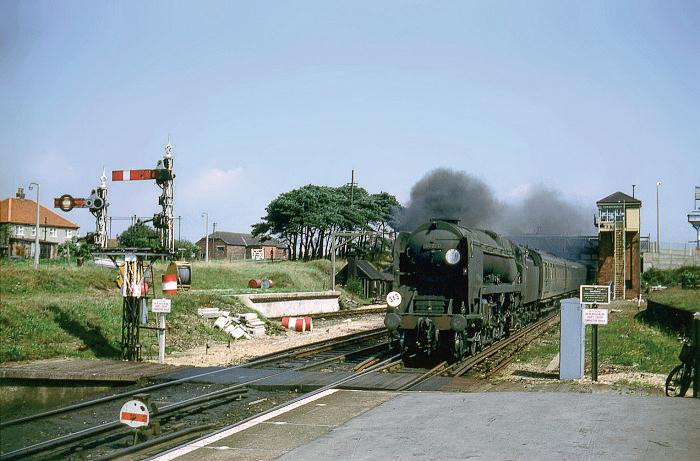
29 STEAM DAYS in Colour:
234: Across Stamford by rail –athree counties jour ney
Setting out from Essendine, Rutland, on the EastCoast mainline, we traverse the former GNRbranchtothe LincolnshiretownofStamford, at its East terminus,beforecrossing to the ex-Midland Rail wayroute through Stamford (Town). Departing west and briefl yentering Northamptonshire, we conclude our travels at the next station, Ketton&Collyweston, Rutland
40 Subscriptions
42 The name’s thesame: Hurricane AndrewWilson looks at eightsteam locomoti vesthat car ried the name Hur ricane,the choicedirectl yinspired by the most powerf ul of winds and then indirectl yperpetuated by aracehorse and the RAF Ha wker Hur ricane fighter aircraft.
53 Preser vation pioneers: DowtyR ail wayPreser vation Society
Bornofanengineering companywith products forthe railwayindustry, John HBird delves into the storyofthe DRPS and its Ashchurch rail centre, from the earlyyears of on-site operations to outings formain linelocomotives.
65 Tail Lamp

As aprelude to theDowty RailwayPreservationSociety (DRPS) ar ticle, we home in on twolocos that soon became cherishedcelebrities of the Ashchurchsite. Emerging from thecutting immediatelysouth of Gleneagles stationinJune1962, Princess RoyalPacifcNo. 46201 Princess Elizabeth headsthe 4.45pm Up fshtrain from Perth. Living on borrowed time,thisCarlisle(Kingmoor)8Pwas enjoying somethingofaswansongasthe dozen survivingmembers of theclass hadbeenplacedinstore in March1961, robbed of theirworkbyEnglish Electric Type 41Co -Co1 diesels, butthenhad a reprieve on an as-requiredbasis. Princess Elizabeth wasrevived from Januar y22until September10, 1962 ,withthisex- Aberdeen duty worked southfrom Perthonseveral occasions. Meanwhile, moneybegan beingcollected to buy‘Lizzie’for preser vation –the doubters said that saving alocoofthissizewas impossible forenthusiasts;thank fully, they were wrong. ItswithdrawalbyBRwas week ending October20, 1962 WJVerdenAnderson/KeithVerden-Anderson
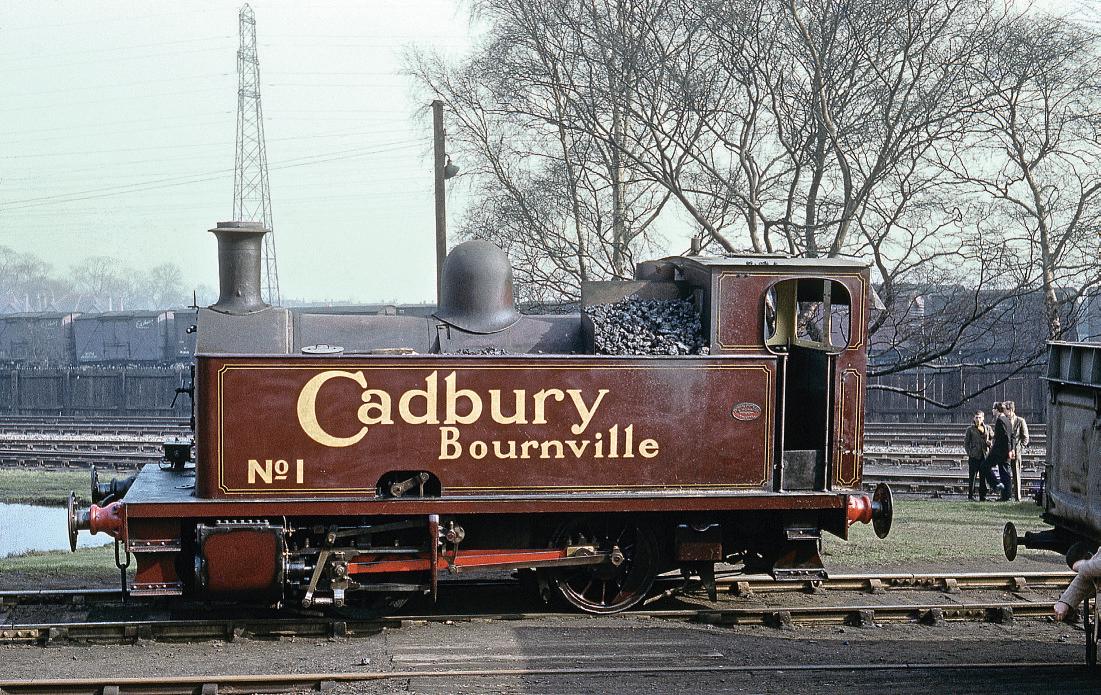
At theother endoft he powers pect rumis0 -4 -0T Cadbur yB ournvilleNo. 1, whichentered preser vation almost by accident thanks to thegoodwill of Cadbur yBrother sLtd.Work- st ainedt hrough coal loading, Avonside Engine Co LtdWorks No.1977of1935iswea ring Cadbur y’schocolate livery andrecordedont he internal railwaysystematBournvilleonM arch 4, 1961,a bout 19 mont hs before theD RPSwas formed ,t he need fora boxvan –note ther akeofCadbury br andedvansint he background –sta rtingaconvers ationt hatput thes alvation of No.1 on thet able .The railwayheretook tr ain- loadsofchocolate to dispatchingbays, with onwa rd rail movement by BR (a nd previously theM idla nd Railway, andLMS), butita lsobrought in dailydeliveriesofmilk, therewas coal incoming fort he factor yboilers ,a nd as awmill wa sa lsoser ved. Invest ment in newdiesels from NBLcamein 1958 /59, Nos. 11 and12, andt heninNovember1962cameNos .13a nd 14 ,a nd thesteam feet wa ssur plus to requirements .The DR PS proved to be in theright placeatt he righttimeinwhatwas aver ysweet arra ngement. AN HGlover/KidderminsterR ailw ay Museum
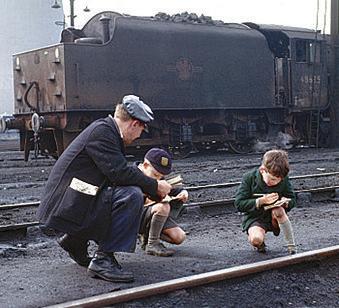

Next month...
Happyafter noons on Hemerdon
Souther nadditions to theNational Collection
Midland memories: Bradford (Forster Square) and the AireValley, 1963/64
The locomoti vesofThor nton Junction engine shed
ASwa veseyinterlude (MarchCambridge line)
On sale Thursday, March20, 2025
Suchisthe nature of SteamDays articles that ‘lastdays’ or lineclosuresare either at theheart of a feature, such as Essendine-Stamfordand Ringwood-Christchurch in this currentissue, or they getamention within captions,broadeningthe overall understandingofa railway’stimeline – Wansford-Stamford, Ashchurch-Great Malvern, Ashchurch-Evesham-Redditch, the‘OldRoad’ (Southampton&DorchesterRailway)and ‘PortRoad’ (Portpatrick &WigtownshireJoint Railway) are in that category.Tefrstfve of thosepredate theBeechingera of widespreadclosuresor, in thecaseof Evesham-Redditch,the writingwas likely alreadyonthe wall.Itwas temporarilyclosedonOctober 1, 1962, duetopoortrackcondition,but wasn’t deemed worthy of investment,sonever reopened
As we near the200thanniversar yofpassengerrailways, it is easy to forget that closures have been with us formostofthattime, with 1831 or so likely oneofthe frst;information is ofen incompletefromsuchpioneeringtimes. Awell-known exampleisLiverpool, CrownStreeton August 15, 1836, when theLiverpool &ManchesterRailway opened itsnew Lime Street terminus, and on NewYear’sDay 1842, it was‘last orders’ at theerstwhile Stag &CastleInn stationofthe Leicester& Swannington Railway, whichclosed afer abrief period knownas‘ Tornton.’
Insuchearly times, theprimary reason forclosurewas that astation wasbypassed, andperhaps wasalwaysa temporaryprovision,but subsequentclosurethreats includedurban railways unable to compete with electric tramcarservices in theearly 1900s,bus competitionaferthe FirstWorld War, includingrailwaysoptingtoprovide theirown busservices over andabove passengertrains, and then therewas theriseofpersonaltransport,and that is when thefoodofclosures setin.
Ironically, it ofen seemsthatmany1960s closures sawstationsand crossing keeper’s houses soon swept away,whereas earlier ones survive–was therea change in resale method?For example,those atAvonLodge Halt andHurn, thetwo intermediate stopsonthe frst railwaytoChristchurch, are extantnearly90years afer their railwayclosed. As told by StephenRoberts in hisChristchurchstations article, thesingle-trackroute datesfromNovember1862, theone public intermediate stationbeing Herne Bridgeuntil 1888, when itsroute wasusurped by anew double-track main linethrough Sway Tereafera backwater, thestation wasthenrenamed Herneuntil July 1897, andthenHurn Come the1930s, ticket salesatHurnwereinsingledigitseachday,and Avon LodgeHaltwas private, andso closurewas inevitable to cutlosses–Christchurchand Ringwood both hadother lines. TeSouthernRailway carriedout thedeedonSeptember 30, 1935, with theLynton&Barnstaple Railwayaxedonthe same day. Interestingly, both have astation buildingthatfound newlifeasa public house.Teone at Hurn is nowthe Avon Causeway puband hoteland is at theend of an of-roadcycle track/pathway alongthe oldtrackbedfromjustoutsideChristchurch, butofcourse, it has road access too.Atthe oldplatformisaFowler0-4-0DMshunter (Works No.22871 of 1939) with ‘drinkinghistory’ – it wasNo. 1 Woodpecker with HP Bulmer LtdinHereford– andwithitisformerPullman Carkitchen secondNo. 340. Te Metro-Cammell vehicle is nowthe OrientRestaurant andftted outasadining areawithasmall bar, stainedglass windowsofering privacyfor diners, or indeed aidingthe culprit in amurdermystery.Respectivelybuilt four and25years afer thestation closed,these railwayitems and their public househelpkeepknowledge of theRingwood andChristchurchlineverymuchalive,which iscertainly somethingtoraise aglass to.Perhaps your ‘local’was likewise,oncearailway building?


Three incidents across 20 miles of the Nith Valley main lineprovide the bac kdrop as David Cross highlights some sleepless mornings with the route’snocturnalpassenger operations in the early tomid-1960s .
Ivery much enjoyedthe ‘Pullman predicamentatPotters Bar’ articlewhich appeared in SteamDays at theend of 2024. As well as beingofrailway interest,Irecalled asimilarincidentwhichtookplace when I wasver yyoung on oneofmylatefatherDerek Cross’ famedrailway expeditions.Inturn, this inspired awider look at sleepertrainson theNithValleyroute,not leastwhenthere wasdisturbed sleepfor thepassengers for onereasonoranother,orindeedahiccup,or worse, that caused troublefor thestafand resulted in late running.
Standard subs for ‘Shefeld’ Let’sgobackto1961, more than 60 yearsago Steamtraction wasstill –justabout –atits peak;see below! Averysimilarincidenttothat at PottersBar occurred at NewCumnock on the former Glasgow&South WesternRailway main line from Carlisle to Glasgowvia Dumfries; NewCumnockissome70miles from Carlisle and45miles from Glasgow. In anutshell, the Pacifc locomotive at theheadofa trainfailed andthe service needed to be rescued.
DerekCross expeditions were planned with almost military precisionifthe number of trains to be photographed wasmaximised. Travellingbetween spotswas carefullyplanned andall of this basedinaworld withoutmobile phones or theinternet. Bags of photographic gear were loaded, flmofdiferentspeeds–remember that?Also, therewerearmfuls of timetables andspecial trafcnotices,books for thedetails of thepicturestaken and, of course, an ABCortwo.Food anddrink also hadtobe loaded, thedaysofmotor wayser vices of 24hour shops stillsomeyears away.All this done
andloaded, it wasearly to bedsowecould set of from Mayboleatabout 5.30amtoget to Carlisle at about8am,bound forShap.
So,ofset father Derekand me.Not much wassaid, andinthose days no radio untilthe BBC Home Serviceburst into lifeatabout 6am. Ever since thosedays, Ihaverecognisedinstantly andgrown to quiteenjoy some of Handel’s Water Music,whichwas played immediately before theBBC beganthe day’sbroadcasting.Iseemto recall that themusic hadnot long startedwhen we approached NewCumnockstation on the main A70 road.Teapproachfromthe northis down ahill, with therailway lineonthe rightas we travelledsouth.Teyoung andalready very excitedmeannounced to DadthatIcould seea DuchessPacifc in thegoodsyard!
Derekautomatically dismissed this and continueddriving andpufng away on his pipe. However, alittlefurther alongthe A70, theroadcrosses therailway on an overbridge, Dereksaw aver ylongpassenger traininthe platform andimmediately turned rightinto thestation yard to furtherinvestigate.Tere in thegoods yard wasindeedStanier Pacifc No.46249 CityofShefeld,the 8P in disgrace having been removedfromtrain 1S26, the northbound overnightsleeper servicefrom London (Euston) to Glasgowvia Dumfries To this day, theovernight sleeperser vice from Euston,now to GlasgowCentral as opposed to St Enoch, stillmaintains the1S26 headcode –some 63 yearslater
What hadhappened? Well,asfar as Derek’snotes go…Iwas tooyoung to remember andinany event‘cabbing’ the disgracedDuchess hadmademyday/week/ month/year… thetechnical detail is notto hand butfrebarissues arewritten in Dad’s diar y. Te netresultwas that No.46249 could
go no further, andanassisting engine hadto be found. Well,New Cumnockisonthe edge of thethenextensive Ayrshire coalfeld andat all timesofthe daythere were coal shunts,coal trains mainly headingtoAyr Harbourwith coal forNorthernIreland wherethere wasno coal,empty wagonmovements and, relatedto all this,light engine movements. Well,British Railways Standard 3MT 2-6-0No. 77018 had

been passingand wasinstantly commandeered to haul thestricken13-coach sleepercar express from NewCumnockfor some or all of theremaining45miles to Glasgow(St Enoch) station–and as fast as possible,please!
CityofShefeld wasatthat time aGlasgow Polmadie (66A)-allocated Stanier Pacifc, oneof ninesuchlocos at that shedinthe second half of 1961, theothersbeingNos. 46222 QueenMary, 46223 Princess Alice,46224 Princess Alexandra, 46227 DuchessofDevonshire,46230 Duchessof Buccleuch,46231 DuchessofAtholl,46232 Duchess ofMontrose and46242 City of Glasgow.Completed at CreweWorks in April1944, No.46429 Cityof Shefeld andits sisterswerethe biggest, most famous locos on theLondonMidland and Scottish regionsatthe time.Tey hada pedigree, andtheyrarelyfailedintrafc
It wasasurprisefor everyone that morning, andsoNo. 77018, at theopposite endof thescale in termsoflocomotivefameand ability, wastaskedwithlifingthis(I’dguess) 500-ton-plusAnglo-Scottishsleeper from New CumnocktoGlasgow.Althoughbuilt more recentlythanthe Duchess, at Swindon Works in August 1954, this little Mogul, thesmallest of theBRStandard2-6-0types andinaclass of just 30 locomotives, hadbeendelivered to Hurlford shedinKilmarnockfromnew; indeed,itremainedaHurlford(67B) ‘lifer’until itswithdrawalinNovember1966.
Facedwiththe daunting task,the little Mogul, more used to potteringaroundAyrshire
on pick-upgoodsand theodd trainofcoal empties, waspreparedfor likely itsmostfamous journeyinits short12-yearlife. Tere wasmuch preparingofthe freand much discussion amongthe traincrews,Ithinkhow to startsuch abig,heavy trainand completethe 2½ miles to thesummitatPolquap,pronouncedlocally as ‘Porwop.’Luckily,aferthatgradient, it is virtually downhill allthe waytoKilmarnockand Glasgow, save forfve miles afer Kilmarnock,toDunlop. Te storygoesthatNo. 77018 might only have takenthe trainasfar as Kilmarnock,where it might have been replacedorapilot engine addedfor therun to Glasgow.
Despitethe unusualmotivepower, reportsinthe railwaypress have as yetproved elusive. Perhapsthe eventwas toosoonafer adeadlineand then considered ‘old news ’ nearly amonth later. However, on afamily note, thever ylastissueof Trains Illustrated in December1961, before appearingas Modern Railways in theJanuary,had aphoto feature called Scottish Newsreel, with threeimages from my father,and twoofthose were of the BR 3MT 2-6-0sleeper train‘event’ at New Cumnock. Te captions andmyfather’snotes aidedthe accountpresented here
Sweetdreamsand arriving on time
Sleeping carser vices inthe early1960s were much more extensive than they aretoday –there were Anglo-Scottishsleepersfrom threeLondontermini to Scotland.Trains
ranupthe East CoastmainlinefromKing’s Cross, from St Pancrasupthe Midlandmain line to Glasgow(viathe Settle &Carlisle andG&SWR routes),and from Euston up theWestCoast andincludingthatrouted to Glasgowvia theG&SWR,and another that diverged at Dumfries forStranraer Harbourand itsIrish Seasailings. Timings were leisurely formanyreasons –big,heavy trains,comfort forpassengers,and thelong distances involved.Inthe summer of 1961, theser vice alreadyshown,1S26, lef Euston at 11.45pm(Saturdaysexcepted), did notstopfor passengerpurposesatall,and wasscheduled to arrive at Glasgow(St Enoch) at 9.30am; it wasan11.10pmdeparture on Sundaysfor a 9.50amMondaymorning arrival. Te train from St PancrastoGlasgow,1S24, wasahead of this,being scheduledtodepartLondon at 9.25pmand arrive at St Enochstation at 7.35am; 9.25pmand 8.30amwerethe Sunday night/Mondaymorning public timings. Whileitisinteresting to consider thenumber of othertrainsthatran to andthrough theNew Cumnockareain1961, thediferentmotive powerand thevarietyoflocomotives andtrain types(freight andpassenger), to alignwithour core subjectwewilljustshowthatthe disgraced City of Shefeld,oncerepaired, continuedtosee useinthe area,and somethingofthe everyday work that theMogulhad been carrying outwhen ‘borrowed,’but also presenting afew photographs of overnight passengerduties over theNithValley
With a13 - coac hl oa d, an 8P wa sb oo ke dfor th eE us to n - St En oc hs le ep er,a nd it wa sfor tu nate th at BR 3MTN o. 77018a nd it sc rewwer e as ke dt os te pi na sl at ea sN ew Cu mn oc k, as th e2½m il es re ma in ingt oPol qu ha ps um mit, th ep ic tu re dl oc at io na nd high es tp oi nt on th elin eb et we en Du mf ries an dK ilma rn oc k, wa sbyt he nl evel or on ly at 1- in - 64 4. Acco rd ingt ot he Ia nA ll an ABC, th ep ower di ffer ence be twee nt he bo oked an dr es cu ee ng in es wa s4 0, 000 Ib to 21,490 Ib,s oo ncet he tr ai nw as on th em ove, it wa sp os si bl yt he seve nm il es or so of de scentat1- in -99/100 beyo nd Mo ssgiel Tu nn el an dd ow nt oH ur lfor dt hatw as on th em in ds of th ec rew, with a5 00 - to n - pl us load at th e re ar.M il es to ne me t, No.77018 co ul dt ic koff ah ar dd ay at th eoff ce –its pa ss enge rt ur ns we re mo re us ua ll yt wo - coac hd ut ie ss uc ha st he Ba ra ss ie to Ki lm ar nock wo rker s’ tr ai no rb et we en Mu ir kirk an dL an ar k. De re kCross
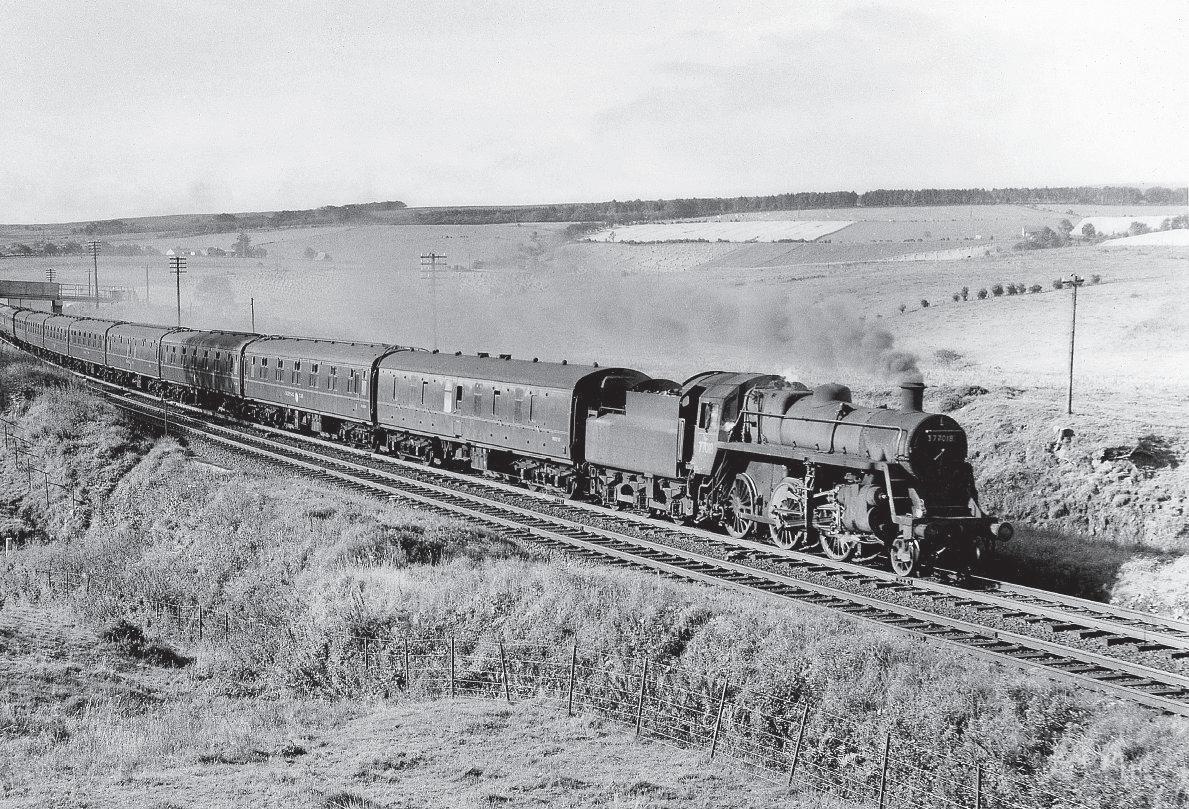

This visual cont ra st seemswor thwhilein termsofsubstitute/emergenc ypower fort he Euston - St Enochsleeper of September9,1961, as Hurlford’s No.77018 andcrewset outon an ea rly- morningcollier yt ripsucha st hat shownhere. In this ca se theengine is anot her BR 2- 6- 0, 4MTNo. 76092, on December 1, 1965.Ithas joined themainlineatNew Cumnock’sBankJunctiona nd is likelyt ak ing itst rain of coal from either Knockshinnoch or Ba nk collieries to AyrH ar bour forexpor t to Nort hern Ireland. At this time ,t hese sites were collectively producingmoret ha n250,0 00 tons of coal ayea r, so such duties were breadand - butter work forHurlfordshed, No.76092 beingont he book sfromA pril 1964 untilits withdr awal in August 1966 . Douglas Mc Naught
main lineinthe early1960s, when themotive poweronthese trains wassurprisinglyvaried.
Te trains of note were thelongstanding Up andDownGlasgow (StEnoch)toLondon duties, four trains in all when both routes southofCarlisleare considered,but also by the summer of 1962 therewas adesire forBRto meet theneedsofthe motorist,thusLondon (Marylebone) wasalsoadestination from St Enoch. Te trainwas acar-sleeper service andran southonMondays, Wednesdays and Saturdaysat6.38pm, with arrivalinLondon at 5.40am(5.50amSaturdays), with theDown duty runningonthe alternatedays–Tuesdays, Tursdays andSundays –departing London at 7.25pmand reachingStEnoch at 6.50am; there wasnocar sleeperbookedfor theFridaynight/ Saturday morningineitherdirection.Teduty wassecondclass only andcost£21 foradriver
At Polquhap,Gresley A3 Pacifc No.60070 Glad ia teur headst rain 1S26 ,t he London (StPancr as)toGla sgow (StE noch)sleeper, on themorning of Thur sday,June8 ,1961. Tr ansferredfromGateshead to LeedsonJune 12 ,1960, initia llyCopleyHill, Glad ia teur wa s Holbeck- allocatedsince November 20,1960, butwould be back on thebooks at Copley Hill threedaysafter this photogra ph wa st aken ,on theeve of the1961summertimet able .Still a va lued asset, No.60070 hadone la st genera l repair aheadofit, at DoncasterfromlateJuly to mid- September, anditremainedonthe core Leedsroute untilDecember8,1963. DerekCross
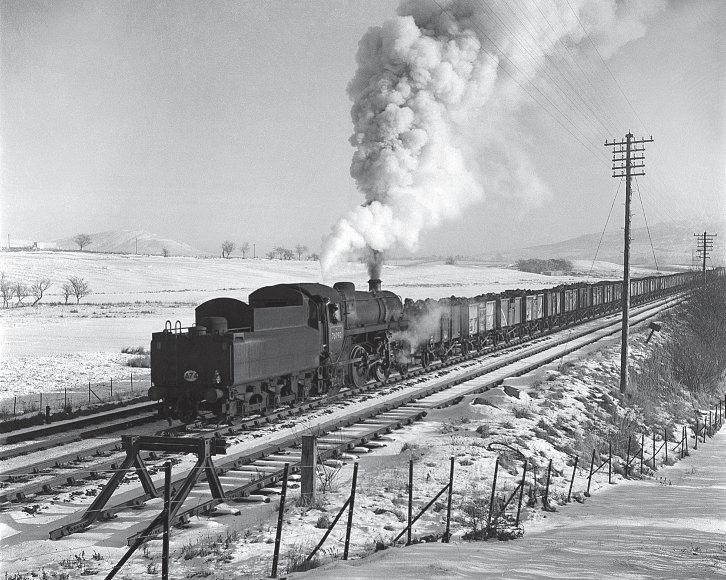


andcar,with£7-10s addedfor each passenger aged 14 yearsorabove (£4-10s wasthe fare for children aged threeto14). Te earlyarrival time is doubtlessanecessity of therigmarole of unloadingthe cars andthe shunting involved
Finally,onthe fringe of ourstory areStarlight Specials,whichstarted runningfromApril 10, 1953, andoferedanovernight trip linking London (StPancras) andGlasgow (StEnoch)on Friday nights, andvice versaonSaturdays. Tird classonly, thefarewas initiallyonly70shillings return (rather than 117s-4d on othertrains); astayofeight or 15 days waspossible. While travellinginordinarystock overnight –from 11pmto9.35amnorthboundand 8.25pmto 6.50amsouthbound– it is fair to saythatthese very much do ft theremitof‘troubled sleep’ but they arenot sleeperduties as such andsoare
outside ourremit.Likewise, theEuston-Stranraer service is notcovered here as it did notpassover our20miles of specifc interest untilthe so-called Port Road wasclosed,soaferJune14, 1965, thereafertravellingthrough NewCumnock and so on andusingthe Mauchline-Ayr link.
Furthersleepless mornings
Whilesomethingakinto‘Sleeperpredicament at NewCumnock’was thestartingpoint of this article, it is inevitable that therewere otheroccasions when all wasnot well on one of theseAnglo-Scottishservices, andtwo spring to mind. In thebig scheme of things, a locomotive failureisaninconvenience in terms of resources, although of interest in that it so ofen leadstosomethingdiferentheadingthe train, whileanother of theincidentscovered
An ea rly- morningJuly1961scene ca ptures Polmadie shed’s St anier8 PCoronation No.46223 Princess Alice entering Kilmarnock stationwiththe overnightEuston- St Enoch sleeperasHolbeck-basedGresley A3 No.60038 Firdaussi awaits departurewitha GlasgowEuston relief duty;the latter will be changedfor LMRtractionatCarlisle. Servingt wo AngloScot tish main linessouth of Carlisle produced motive powervariety on theNithValleyroute once theWestRidingwas swallowedupbyan enlarged NorthEastern Region andHolbeck graduallylostits Midlandheritage. Thet wo Pacifcsinshotwould be lost within aboutsix weeksofeachother,the A3 lastingslightly longer,Type41Co -Co1 dieselsgaining a foothold on thesleeper traf fc throughhereas earlyasEaster1962. DerekCross
here couldsoeasilyhaveended in tragedy. Inevitably,unlessyou happen to be in a signalbox when news breaks –and forsleeper woes, that will be during thesignalman’s night turn,10pmto6am,orearly turn,6am-2pm –or by chance areatthe sceneofafailure and have thepresenceofmindtoask questionsof anystafoverseeingoperations, theretends to be incompleteinformation as to anyout-ofcourse incident. To acertain extent, that is the case with all of thosedescribed here,and we hope,perhaps, that furtherinformation may surface from readersvia theTailLampsection Te end-to-endtimetablingofsleeper services tendstobebased around thepracticality of leavingasthe eveningsets in, having a comfortablenight’s sleep, andarriving, several hundredmiles later, freshfor thenew dayand at apracticaltimethatisjustright formost travellers. Forthe most part,these trains go unseen andunphotographedastheypass throughthe night,sightings mid-route largely thepreserveofon-shif railwayworkers.While thelongerdaylight hoursofsummercan aid some photographic opportunities forenthusiasts wholivenearone of theextremities of asleeper
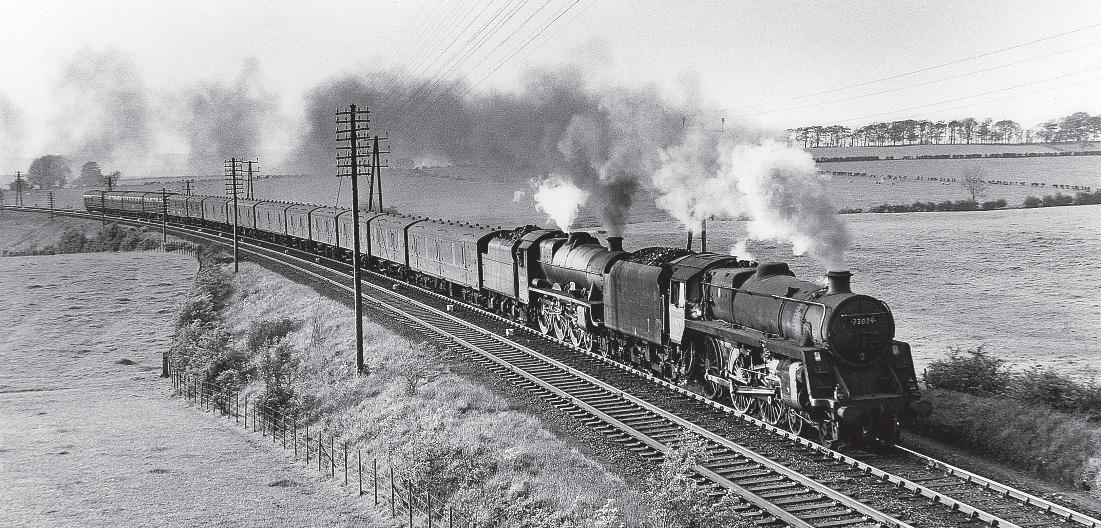
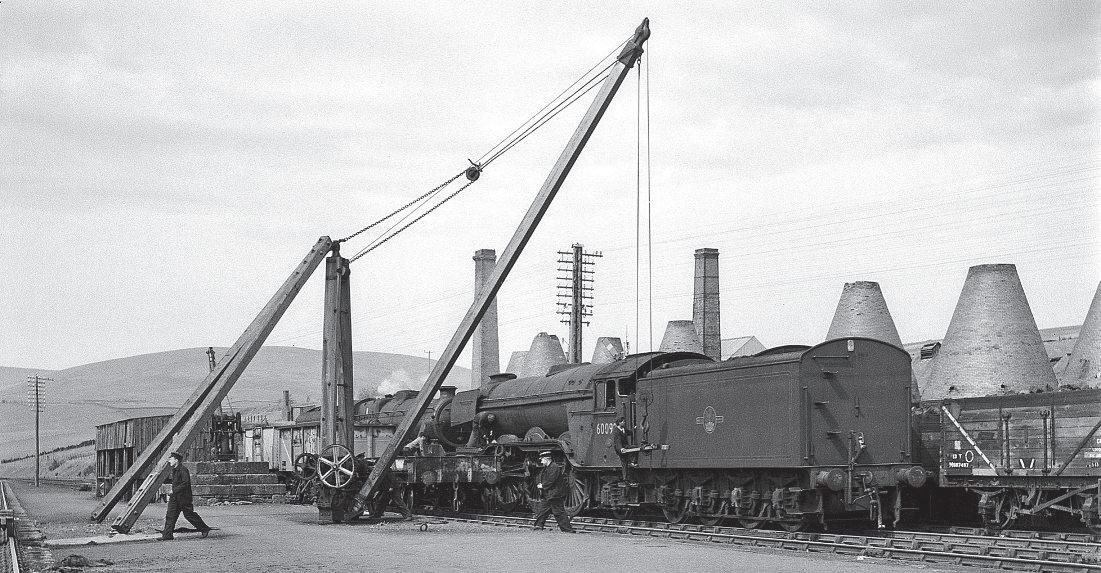
Havi ng fa il ed at Sa nq uh ar on aD ow nove rn ig ht sl ee pe re xt ra ea rl yo nM ay 16 ,1964, th ro ug ht he us ua lA 3p ro bl em of an over he at ed mi dd le big en d, th eoffen di ng pa rt of No.6 00 92 ’s an at omyi slif te df ro mt he gr ou nd to be lowe re di nt ot he Pa ci fc ’s te nd er by th ef ve -t on Scot ch de rr ic k go od sy ar dc ra ne ,t he ba ckdr op do mi nate dbyS an qu ha rb rick wo rk s. Th ef ai lu re of Fa ir wa y le dt oa no ut - an d - ba ck tr ip fo rN o. 45463f ro m Hu rl fo rd ,t he 4- 6- 0u lt im at el yt ow ingitaway. Once at Hu rl fo rd ,a nu ns ucce ss fu latt em pt wa sm ad et oe ffec tr ep airs ,s ot he Gr es leyPac if ch ad to be re move de ls ew he re fo ratt ention ,a lt ho ug ht he engi ne re co rd
Fa
nt on to se eo ut th es um me rb ut wa scon de mn ed on Oc to be r12, 1964 Do ug la sM cN au gh t
service,itisfairtosay toothatoccasionallya late-runningservice cantakeyou by surprise
Forexample,inregard to timings, the weekdays 1S24 trainfromLondon(St Pancras) in thesummer of 1962 appearsinthe Scottish Region public timetableasfollows:
London (StPancras) dep 9.25pm
Shefeld (Midland)dep 1.37am
Leeds(City)dep 3.04am
Carlisle dep 5.42am
Annan6.05am
Dumfries arr6.24am dep 6.32am
Tornhill 6.51am
Kilmarnock arr7.43am dep 7.47am
Glasgow(St Enoch) arr8.30am
Te accompanying notesstate that sleeping coaches(SC) andthrough coaches(TC)run London-Glasgow,and that Tornhill is astop ‘onnotice at Carlisle to setdownfromSouth of Carlisle.’ If your daystartsearly,bythe time thetrain reachedKilmarnock, it wasmorethan possible to seethe sleepercall, andthere wasa chance of daylight at theright time of year
In the1960sthere wasalsothe possibility of reliefduties,whichtendedtorun aheadof themaintrain, so arelesslikelytobespotted Fast-forward to thenight of May15/16, 1964, andparticularlythe Saturday at about8.30amin Sanquhar –26¼ miles north-west of Dumfries and 32 miles from Kilmarnock.Itwas notreasonableto expecttosee anythingsleeper-related so late in the morning, andwhile therewas no signofthe train, GresleyA3PacifcNo. 60092 Fairway wasparked at thebackofthe goodsyardwearingthe 1C37 traincodeofareliefsleeper duty.Te Gateshead-
allocated locomotive,presumablyaddedtoan Anglo-Scottishdutyasafresh loco at aLeeds reversal/loco change,had failed with an overheated bigend.Ifsomewhere near to time,thismostlikely happened circa 7am, andthe circumstances of the rescue of itstrain, andwhattookitforward,are unknown, although somethingofthe next events forthe disgracedlocomotiveare
Local enthusiast DouglasMcNaught happened to be at thestation that morning, andagain at about12.30pm, andbythenthe Hurlford breakdowntrain was on site, its locomotive soon shunting theerrantA3from thebackroadofthe goodsyard. Te shuntwas to facilitate theuse of theyard’stimberderrick to lif thefailedbig endintothe tender space Tiswas just an initial stageofthe revival, whichwas then to be continuedatHurlford. On theface of it,Sanquharmight be considered out of theway,but thehealthy amount of coal trafc in therelativevicinityprobablyled to agoods engine stepping in to save theday,justasBR 3MT No.77018 didbackinSeptember 1961.
Ourfnalexample of ‘troubledsleep’ison thenight/morningofSaturday/Sunday,August 13/14, 1966, by whichtimethe sleeperservice wasinthe handsofType4 1Co-Co1dieselelectricsand Glasgow’sStEnoch terminus had closed,fromJune27thatyear, Glasgow(Central) having gained itswork. On this day, my father wasmade awarethatthe Nith Valley main linewas blockedand theconcludingpictures show what he found. Train1M13, the10.10pm Glasgow (Central)-London(Euston)sleeper, hadhit alandslipatArdochand itslocoand most of itscoaches were derailed.However,the real drama wasinthe dead of night when the rain waslashingdown–there wasgenuinefear of majorinjuries, or worse, andalengthy and
unsettlingordealfor passengers ensued until their rescue wasachieved.
If Imay,itseems appropriatetotellthe news as thepeopleofScotlandfrstreadit. On page 10 of the DailyRecord of Monday,August 15, areport read ‘Passengersinlandslideperil,’ supported by ‘Chaos in Floods’tofurther catch theeye, accompaniedbyaphotographcaptioned:‘Te derailed diesel engine andcoaches lie on theline near Sanquhar afer foodshad caused alandslide.’ Beyond theheadlines, here is thereport:
An express trainran into alandslide in thedarknessearly yesterdayand wasfungof thetrack
Passengers screamed as thecoaches smashedagainst arockface
No onewas hurt,but 272 passengers were stranded forsix hoursona lonely stretch of linebetween Sanquhar andTornhill, Dumfries-shireuntil helparrived.
Te train, the10.10p.m. from Glasgowto London Euston,ran into thelandslideatthe height of ablindingrainstorm
JamesDuncan, of Glasgow, thedriverof the2000 horsepower diesel whichwas pulling thetrain, said later: “I hadbeenwarnedof possible hazards, andIwas only doing15 miles an hour when we crashed
“I couldn’t seea thingonthe track, then, suddenly,Iwas on topofrubble.”
Eleven of the15coaches lefthe track, throwing passengers aboutinside thecompartments.
Both lines were blockedand theguard set up warningdetonatorsalongside them, while othercrewmembers comfortedthe passengers.
Assistantguard Alistair Robertson, 45, of 1025 Argyle Street, Finnieston, Glasgowran almost half amilethrough thestorm to aroad to raisethe alarm.

Th eL ow th er Hi ll soffer an im pr es si ve ba ckdr op to de ra ilme nt ca rn ageatA rd oc ho nAug us t14, 1966 .A bo ut 15 ho ur so rs oa ft er th e10.10 pm Gl asgow - Lo nd on sl ee pe rfou nd it se lf at th em ercy of am as si ve st or ma nd pl ough ed into al an ds li pata bo ut ha lf pa st mi dn ig ht ,t he we at he rh as cl ea re da nd th re eb re akdown cr an es ar eo ns it ee ffec ti ng re cove ry,t he pa ss enge rs lo ng si ncer es cu ed ;atimp ac t, so me 20 0y ar ds of tr ac kw as ri pp ed up.Tha nk fu ll y, th ec ar ri ages ma nage dt os tayn ea ru pr ig ht ,t he pa ss enge rs ke pt on boar d, ou toft he te rr ib le st or m, wh il eh el pw as so ug ht –g ua rd Do na ld Th om ps on pl aced pr ot ec ti ng de to nato rs as he wa lked ab ou t2½m il es ba ck to th eM en nock ho me sign al ,f ro mw he re he ph on ed Sa nq uh ar ‘b ox to ad vi se th at th elin en ee de dt ob ec lo se di nb ot hd ir ec tion s. In tu rn ,t he sign alma nconta ct ed Tr ai nContr ol in Gl asgow, wh ic h ca ll ed th ee me rgency se rv ices an da le rt ed th eD umfr ie sa re am an ager.The latt er ar ra nged re sc ue bu se si nt he ho pe th at th ey mayget th ro ug h fo od wate ra nd pu rl oi ne da ne ng in et hatw as ju st in of fac ircu ss pe ci al .I tr ea ch ed Ca rr on br idge at 2. 30 am an dfou nd fr em an Al exan de rTho ms on dr ench ed an datt he pointofcolla ps ea sh ew alke ds ou th to se ek he lp.The fr eb riga de wa so ns it ef ro m4 am an dh el pe dt he pa ss enge rs on to bu se sat6 am ,a nd th en at wo - coac ht ra in re ac he dt he cr as hf ro mD umfr ie sat6 .2 5a m. De re kCross
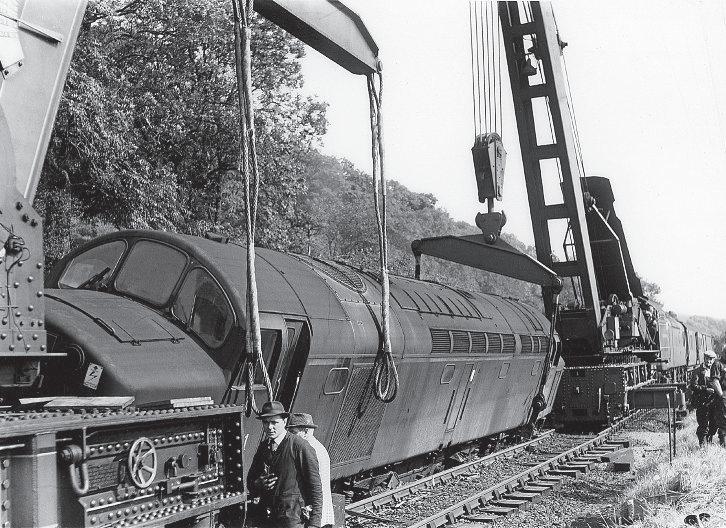
Relief train Police were alertedand four busesand arelief trainset out.
It took them SIXHOURS of battling throughfoodwater to reachthe stricken express
Te passengers were takentoDumfries, wheretheyweregiven amealbeforecarrying on to London in twospecial trains.
Be fore th ey lef tD um fr ies, th e pa ss en ge rs to ld of th ec ra sh an dt he ir sixhour orde al
Tw o7 5 - to nc ap ac it yC ow an s, Sh el do ns te am cr an es bu il tf or th eS co tt is hR eg io ni n1962 ar ea th an dt or e - ra il th et ra in en gi ne , En gl is hE le ct ri c1Co -C o1 No .D 311, la te r Cl as s4 0N o. 40111; it se rv ed un ti lM ay 3, 19 81.R S107 5/ 75 is in th ef or eg ro un d, an d RS10 94 /7 5i sa lr ea dy br ac ed to li ft th es ou th en do ft he lo co ,i ts ou tr ig ge rs gi vi ng af rm fo ot in g. No te ho wt he di es el ’s fn al po si ti on pu sh ed ov er th et ra ck of th eD ow nm ai n li ne ,s ev er in gi tj us ts ho rt of th ec ra ne ’s po si ti on .T he sp ee dl im it he re wa s5 5m ph , bu tf or ew ar ne dt ha tc au ti on wa st he ke y wo rd ,t he dr iv er of th es le ep er tr ai nw as on ly tr av el li ng at ab ou t15m ph an dt ha t do ub tl es ss av ed li ve s. Un se en to th er ig ht , th el an dd ro ps aw ay to th eA76 ma in ro ad an dt he Ri ve rN it h. De re kC ro ss
Walter Burke, 34, of 28 Campbell Street, Maryhill,Glasgow,was on thetrain with his wife,Betty,32, andson James, 10.
He said:“ Te trainswayedand shook.I thoughtitwas goingtotelescope.”
SistersJeanand SallyGreen, of 16 Leverhulme Drive, Stornoway, were in thesecondcoach Sally, 14, said:“Iwas pitched on to thefoor. I gotaterriblefright.”
Jean,18, said:“ Te traingaveaviolent jerk,thenIsmelled thebrakesburning. It was pretty frightening.”
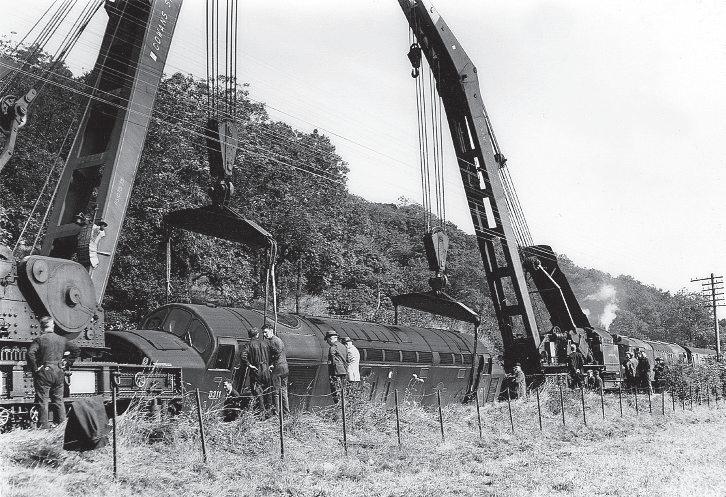
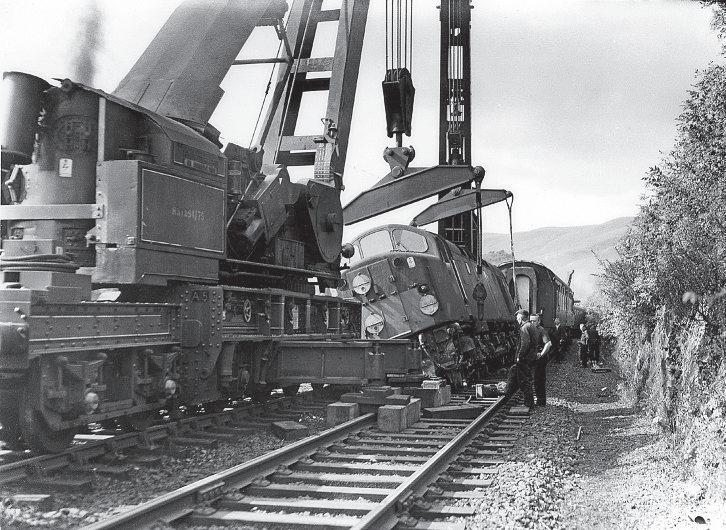
My fath er,D er ek Cr os s, is nowb es id et he Up ma in li ne as th eb ra ce of 75 - to ns te am - powe re d cr an es wo rk in un is on to li ft th eTyp e4a nd re po sition it on to it sw he el s. Th ed es ig nof dies el sa nd el ec tr ic sm ea nt th at th eirlif ti ng points we re ge ne ra ll yove rt he bogiecentr es ,a nd sp ec ia llif ti ng ap pa ratu sh ad to be us ed –t hi ss aw allb ut th el ar ge st cr an es un ab le to pe rfor m su ch at as k. Wh il eB Ri nves te di nn ew 75 - to nd ie se l - powe re dc ra ne si n1977, th er ew as al so ap rogr am me th at sawt he 10 st ea m - powe re d75 - to nc ra ne sconve rt ed to dies el - hydr au lic op er at io n, an dw hi le No.R S1075/ 75 wa ss cr ap pe di nFeb ru ar y1994, No.R S1094/ 75 ,i nt he fo regr ou nd ,r ea ch ed pr es er vat io nw it ht he Mi dl an dR ai lw ay Tr us t. De re kCross
Graham Collins, 23, of 3ArmadaleStreet, Dennistoun, Glasgow, said: “Everyoneinthe coachwas terrifed. Iwas amazedtofnd that no onehad been hurt.”
Te driver waspraised by Mr.Andrew Middleton,of88Frankford Road,Stepps, who said: “I don’tknowhow he managedtoget the trainstopped withoutmoredamage.”
ABritish Railways spokesman said last night:
“Telineisstillblocked –wedon’t expect to getitcleared until tomorrow night.Trains arebeingdiverted.”’
Te stormalsosaw theRiver Nith burstits banks, foodingshops andhousesinDumfries, andthere were pictures tooatNew Stevenston andnearBothwellBridgeinLanarkshire,
andasfar east as Greendykes, Edinburgh. As forDumfries, naturallythe Dumfries and Galloway Standard wasalsoonthe scene, and whilethe stor ywas short-termnewsinthat therewerenocasualties, it is appropriateto also presentashort piecefrom Te Sunday Post report that waspublished oneweeklater, on August 21, as follows:
‘MrAnd MrsMacdonald SatFor Five Hours–TooScaredToMove
Last Saturday night Mr andMrs Calum Macdonald caught thenight express from GlasgowtoLondon.
Th et wo cr an es we re bu iltfor ju st su ch a pu rp os e, th eTyp e4 ,n ew in De ce mb er 1960 , we ig hi ng 133t on s. In th ea ft er math of th e Ha rr ow &Wea ld st on ea cc id ent, ar ev iewof br ea kd ow na rr ange me nt sl ed to ad ozen of th es e75 - to nc ap ac it yc ra ne sb ei ng purch as ed , an d10of30 - to nc ap ac it y, as pa rt of th e Mo de rn is at io nPla n, with twoofe ac hs ize dies el powe re d. Su ch cr an es we re st rategica ll y locate d, with RS10 94 at Ki ng mo or an dR S1075 at Po lm ad ie ,t he re st ingp os it io noft he loco an dt he seve re dlin er es ulti ng in th el at te r re ac hi ng Ar doch vi aK ilma rn oc k. Beyo nd th e Ki ng mo or cr an ei saB RS ulze rTyp e2B o- Bo, wh ic hm os tlikel yd eliver ed th ec ra ne on site , ap ro pe llingm ove; it ha satl ea st on ecoa ch co up le dt oits fa re nd De re kCross
Just as they were settlingdownintheir bunks, aroarloader than thethunder of the trainbegantofll thecompartment
It waslikegiant drumsticks beatingonthe carriage roof
It soundedasifthe windowswerebeing bombardedwithgravel.
Te trainhad runslapintothe middle of thebiggest Border cloudburst in years.
Ten, withoutwarning,Mrand Mrs Macdonald were almost thrown from their bunks.
Teir carriage suddenly begantoheelover. Te trainshuddered to ahalt.
MrsMacdonald clamberedacrossthe slopingfoorand opened thewindow. Earth, stones, andrainpouredin.
Te trainhad been derailed in thestorm Mercifully,abankhad preventeditfrom perhapscrashingright over Te trainstafchecked that the300 passengers were safe.
Buttheywerewarnedtomoveaslittleas possible.Suddenmovementmight causethe traintokeelovercompletely.
So Mr andMrs Macdonald were marooned in theircompartment,hardly daring to move
Tey’dnoway of knowingatwhatmoment asuddenshif of weight or pieceoftrack weakened by therainmight perhapsturn mishap into disaster
By thetimerescueteams reachedthem at 5a.m., they hadspent themostfrightening fvehours of theirlives.
It seemed incredible no onehad been hurt
Andfor that they’veasked Te Sunday Post to expresstheir gratitude.
To thedriver, whoseskill savedtheir lives when hisexpress struck fallen rock.
To thefreman, whobattled throughthe stormtosummon help.
To theguard whomadesuretheywere safe anddid so much to reassure them during thenight
To thetrain stewards,who calmly served teaontrays as though nothinghad happened AndtoBritish Rail fortheir magnifcent handlingofthe emergency.
Teyprovidedrescuebuses to Dumfries, free breakfasts there, free telegramsatCarlisle to notify families, andfreebufet at Crewe.
“I’vecriticisedB.R.manyatime,”saysMr Macdonald.“Nowit’sdifcult to express just howgratefulweare.”

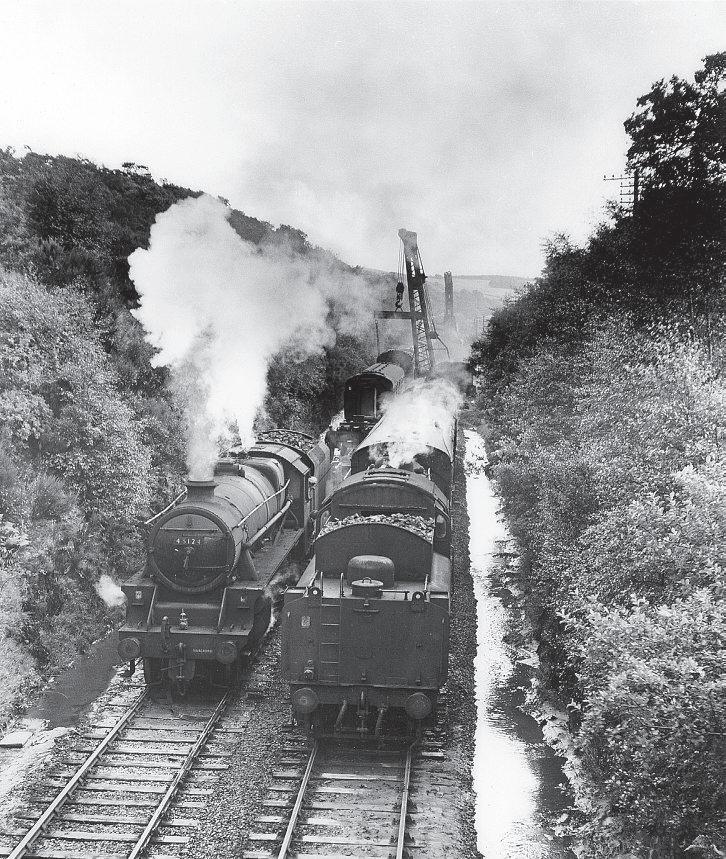
An over br idge at th en or th en doft he cr as hs it ep rovi de so ur fn al va nt agep oi nt of th er ecover y of tr ai n1M13. So me of it scoa ch es ar ei nv iewo nt he le ft - ha nd (U p) li ne ,b eh in dS ta nier ‘B la ck Fi ve’4 -6 -0 No.4 5124 ,a nd to it sr ig ht is BR 4MTN o. 76102, with th e30 - to nH ur lfor dc ra ne beyo nd .B ot hl ocos ar eofH ur lfor d, th eS ta nd ar da pp ar entl yp ro pe llingt he cr an eo nt os it e–Sa nq uh ar is th en ex ts tation to th en or th of he re ,a bo ut fo ur mi le saway, an dlikel yt he 5MTi s on ha nd to tr ip anyr e - ra il ed coac he st ot haty ar dfor anyc he ck sa nd po ss ib le re me di al wo rk , be fo re al onge rjou rn ey.The la st coac hw as re - ra il ed ea rl yo nt he Mo nd ay mo rn ing, 30 0t on sof de br is wa sc le ar ed aw ay,a nd re pa ir swer em ad e–b ot hlin es we re re op en ed on Tu es day, Augu st 16 . De re kCross
We ar en ow at th eK il ma rn oc ke nd of th e tr ai no nt he sa me af te rn oo n/ev en in ga nd fn ds te am cr an eN o. RS10 73 /3 0r e - ra il in g co ac he s, in th is ca se on eo ft he sl ee pi ng ca rs .A no th er cr an eo fC ow an s, Sh el do n& Co ma nu fa ct ur e, th is ti me of 19 43 bu il d, it wa so ne of 11 of it st yp et ha tw er en ew to th eL MS du ri ng th eS ec on dWor ld Wa r. Af ew mo nt hs af te rt he pi ct ur ed re co ve ry op er at io n, on Oc to be r6 ,H ur lf or ds he d cl os ed an dN o. RS10 73 /3 0w as tr an sf er re d to Ay r; it wa ss ti ll at Ay ri n1981b ut wa s la te rs cr ap pe d. In th ef or eg ro un di st he cr an e’ss ix- wh eel ed ru nn er,c ar ry in gv ar io us re co ve ry eq uipm en ta nd al so pr ov id in gt he se cu ri ng pl ac ef or th ej ib wh il et he cr an ew as in tr an si t. In ad di ti on ,a to ol va ni sl ik el yi n th ec on si st . De re kC ro ss
Later, news came outthatone couple receivedpayment from anewspaper for their stor yofthe nightmare trip,perhaps the Macdonalds, andthattheysentthe cheque to arailway benevolentinstitution as agesture of gratitude.
Mu ch ot he rd et ai li sw it hin thec apti ons to my father’s photog raphs, butiti sof note th at thestory wa snot qu iteove rfor ther ai lw ay me ni nvolve djustyet. As late as Oc tobe r1 0, 196 6, TheS cotsman ran ashort pi ec en amed ‘G ol den th an ks to railwaymen.’App arently, thed rive r, fi re man andt wo gu ards on thet rain we re to sh are a£ 300 cheque se nt to them by a‘gr atef ul womanp asse nger.’ Thestory of then ig ht is re told i nbri ef,and ‘t he woman, who wi she storem ai nanony mous ,feels th at the pa ss enge rs owet he ir live stot he ac ti on of thefou rmen .’
Te short report concluded: ‘Ata ceremony in GlasgowonWednesday,the driver,MrJames Duncan (47), 11 Jedworth Road,Drumchapel: theFireman,Mr Alexander Tomson (30),606 Rutherglen Road: andguards, Mr Donald Tompson(54), 11 Arnprior Quadrant,Castlemilk,and Mr Alistair Robertson(45) –all of Glasgow, will receive £75 each andfve guineaseachfrom BritishRail.’
Th es am es tory wa st ol di nt he De cembe r1 966 is su eof Th eR ai lw ay Magazine ,p ag es 686-688, comp let ew it h th re eoft he ph ot og raph st aken by my fath er.Whi le th el oc om ot iv ew as ad ie se lel ec tr ic, st eamt rac ti on wa si nv ol ve di n th eres cu e, with at le as tt hree st eamc rane s se nt to cl eart he lin e–m os tl ikel yf rom Carl is le an dPol ma die fort ho se of 75-t on capa city to work in tand em fort he lo co lif t, buta ls oa 30-t on crane from Hu rl ford , No.R S1073/75, wh ic hw as us ed to lif tt he co ac he s. At le as tt he de li ve ry ru nofone of th es ew as st eam-h au le d, wh il eanoth er st eaml oc ot oo kawayt he co ac he sa st he y we re re -rail ed ,s oIh op et hatt hi si ns ig ht is of inte re st to SteamD ay s re ader s. It is a pr im ee xamp le of th et raditi on al rail way an dh ow it ss taff lo oked af te rp as se ng er s du ri ng an unfores ee nc ri si s.
SteamDays wouldliketojointhe author in thanking DouglasMcNaughtand Jim Lindsayfor theirassistanceintracking down thenewsreports of theperiod.
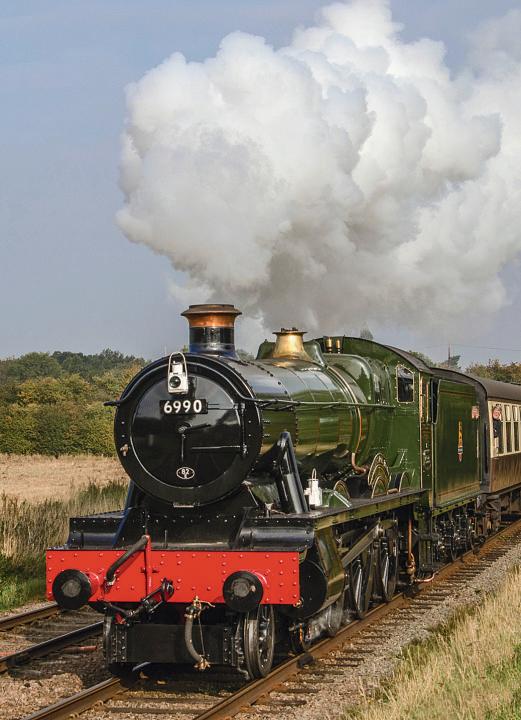

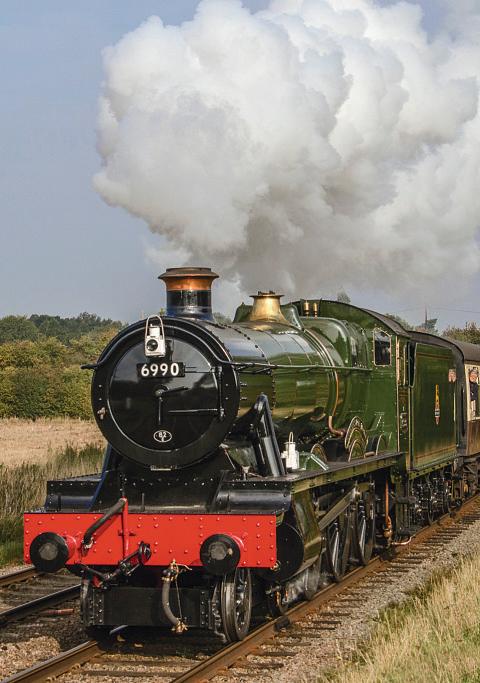



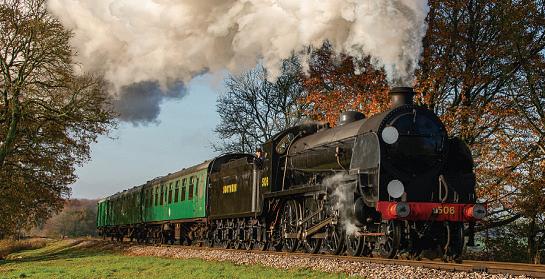











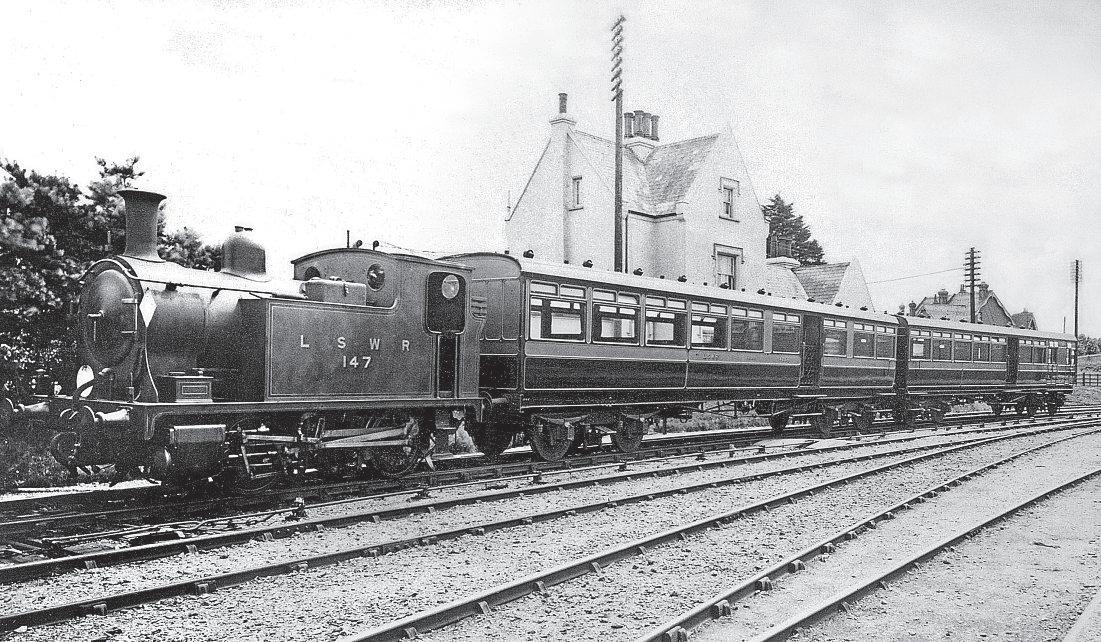
Fir st reac hed by train in November 1862,gaining three railways and losing its fr st 90 year sago this September, Stephen Rober ts trac ks the optionsfor catc hinga train at Chr istc hurc h.
Railway stations canbepoignantplaces, entrepôtsfor greetings andfarewells Youjustneed to watch BriefEncounter (1945) andTrevorHowardand CeliaJohnson wrestlingwithemotionsaswellasgritinthe eyeatCarnforth station(as ‘Milford Junction’) to understandthis. Railwaystationswerethe Victorians’equivalentoftoday’s airportand cruise terminals, andwhile thetickets maynot lead to such exotic places, thejoy of embracinga returned lovedone or theheartbreakexperienced from watchingatrain graduallydisappear with a soulmate aboard arejustasstrong.
In 2012, Christchurch (Dorset’smosteasterly station) celebrated the150thanniversary of the railwaycomingtothe town centreonNovember 13, 1862, acentury andahalfofthose comings andgoings. Neitherwas this Christchurch’s frst station, norwas it thelast– forarelativelysmall boroughofsome40,000 souls, it has quitea convoluted railwaystory
Priortothe railway’sadvent, Christchurch reliedprimarily on waterfor itstransportation, beingonthe Hampshirecoast (Dorsetsince local government reorganisation of 1974),so heavy with coastalshipping, butalsoonthe rivers Avon (fromSalisbury)and Stour(from Wimborne). HengistburyHead, apromontorywhich ofers protection to Christchurch Harbour, wasonce Britain’smostimportant port,tradingacrossthe Channel,but you’dhavetogobacktothe Iron Agefor that.Its position betweenthe coastand
Freshout of EastleighWorks,DrummondS14 0- 4- 0T No.147 hasbeendespatchedwitha‘gated’ motor-setfor an of fcialphotographinOctober 1910.The location is thefrststation at Christchurch, whichclosedonMay 30,1886, afterbeing displacedbythe onethatstill serves thetowntoday,a shor t distance to thewest. TheonlyS14scompleted,Nos.101 and147 andwerestationed at Bournemouth to work thelinebet ween Christchurch andRingwood, andalsothe Lymingtonbranch. They seem to have performedreasonablywellonthe former butwerelesswellsuitedonthe faster Lymington branch trains,these returningtoDrummondO20 -4 -4Toperation in mid-1911.S14 usecontinued on theHurnbranchuntil May1913, when motor- equippedStroudley ‘Terrier ’0 -6 -0TNo. 735tookover duties andthe S14s joinedthe smallerand equallyout of favour C14class 2-2- 0Tslargely relegated to shunting duties;the C14s hadseensomeser vice alongsideDrummond’ssteam railmotors in and around Bournemouth, butmostwereoffoadedwhenthe WarOffce came knocking during theFirst WorldWar. Cour tesy of theRailway &Canal HistoricalSociety,Jeoffry Spence Collection
tworiversmeant that Christchurch wasalso easily defended, henceitbecameafortifedburh in thetimeofAlfredthe Great. Te horseand ‘Shank’s Pony’would play their part too.
As with elsewhere, thecomingofthe railway wasanimportant eventinthe developmentof thetown, although initially therailway didn’t actuallycometoo closetoChristchurchitself. In 1847, thefrstrailway in thevicinitycame to Holmsley,inthe NewForest, whichwas knownonits openingasChristchurchRoad, butthiswas ahealthy seventoeight-mile yomp away from thetownitself, andoverremote, sparsely populatedheath to boot. Te station wasonthe Southampton& Dorchester Railway, Christchurch Road beingonthe sectionbetween Brockenhurst andRingwoodofalinealso dubbed ‘Castleman’s Corkscrew’ afer Charles Castleman,the Wimborne solicitorwhose brainchild it hadbeen, the‘WaterSnake’line, andthe ‘Old Road’byrailwaymenwho knew it as theoriginaleast-west routeinthese parts.
A15further yearspassedbeforethe railway hitthe town centrewiththe openingofthe linetoChristchurchvia Ringwood –onceit arrived, it wouldtransform Christchurch.In themeantime, thecoach stillplayedits part In 1850 theAvonCoach lef Christchurch for Salisburyat7.45am, returningat5pm,and in 1858 thesamecoach lef Salisbury’sGWR stationat 9.30am, arriving at Ringwood at
1.40pm, from whereitwas possible to getthe traintoChristchurchRoad(Holmsley). Having hadarailway in thevicinitybut no town centre station, it wasinevitablethatthe denizensof Christchurch wouldseekpreferment.
Te Ringwood,Christchurch & BournemouthRailway Companywas incorporated in 1859 to builda lineofroughly 7¾ miles in lengthtoconnect Ringwood with Christchurch,and thefrstmeeting of itsdirectors washeldatits registered ofces, 2Leadenhall Street, London,onAugust 16 that year.Almost ayearlater,onJuly14, 1860,there wasafurther meetingatthe King’s Arms in Christchurch at whichthe surveyor Capt WilliamMoorsom (of Lickey inclinefameand whosefatherhad fought at Trafalgar) reported on theprogressofthe earthworks, whichwereone-quarter completed Te engineer wasnoneother than thefamed TomasBrassey whohad builtathirdofBritain’s railways by 1847. Te manwho’d needed to be convincedwas JamesHarris, thirdEarlof Malmesbury, residentofHurnCourt andacross whoselandthe railwaywould snake, andwho had22acres bought from him at acostofabout £500. Te railwaycompany also hadtopay about £270 compensation forthe common land that it wouldtrash,while Avon LodgeHalt, aprivate station, hadtobeprovidedfor theconvenience of theearl, whohad also been aForeign Secretary. Incidentally, thesecondearlwas responsiblefor
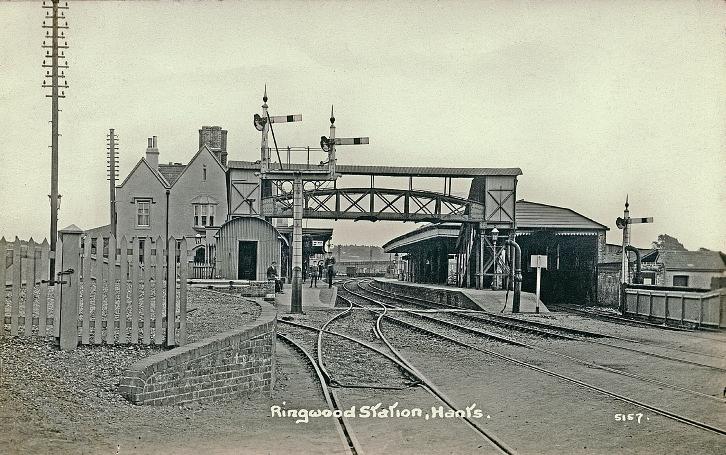



nt il Oc to be r21, 1930 ,w as on an in de pe nd ent li ne fr om th eb ay platfor matR ingwoo d. Af te rt hatd at e, th elin ei nt he bayw as tr uncate datt he we st en d, th eb ra nc hm ad ea co nn ec tion with th eD ow nm ai nlin eatB ic ke rl ey Cr os si ng an dU p tr ai ns ra n‘ wr ongr oa d’ fo ras ho rt di st ance to th ec ro ss over ne ar We st ‘b ox .A th ir db ri dges pa n wa sa dd ed al ongs id et he S& Dt oa ccom mo date th ei nd ep en de nt li ne over th eR iver Avon be fo re th elin et ur ne ds ha rp ly so ut ha nd over th eK ingS tr ea ma nd up aw ay fr om th ew at er me ad ow st o fo ll ow th econto ur soft he hi ll si de ab ovet he ri ve r. Th eA 31 road over br idge is in th ed is ta ncei n th is view of at ra in on th eb ra nc ho nS ep te mb er 28 ,1935. Mark Yarwoo d/GW Tr us t
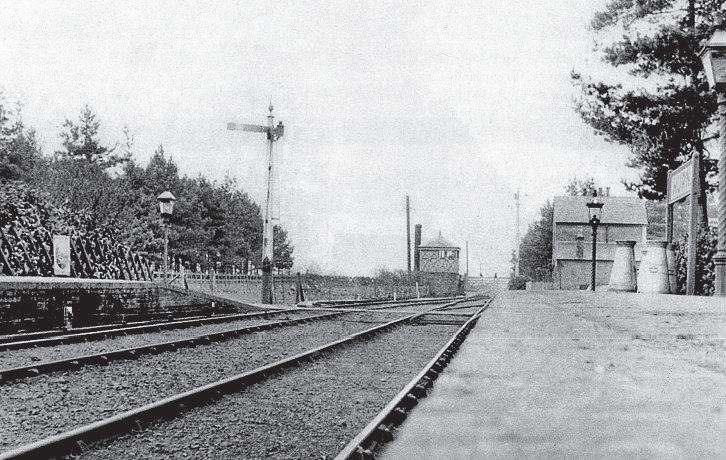
An EdwardianpostcardviewofRingwood station, lookingeastwitha footbridge spanning themainlineplatforms andthe dedicated Christchurch branch platformonthe right, protectedbyatrainshed.The market town of Ring wood joinedthe railwaynet work on May1, 1847,withthe openingofthe Southampton& Dorchester Railway. It became ajunctionwhen thebranchopenedonNovember13, 1862 .Tyer’s tablet workingwas in useoverthe Hurn line and anytrain leavingfromthe trainshedwould have to be in possession of thesinglelinetabletifit ventured beyond here. John AlsopCollection
thetermLabradorRetriever becomingwidely used,asweknowthe breed today; originally the St John’s waterdog,orLesserNewfoundland, and native to Canada,the Harrisfamilywas among thefrsttoimportthemintothe UK andchanged thenametoLabrador, also an area of Canada, presumably to diferentiateitbetween thelarger Newfoundland dog.Teprivate halt wasalsofor theconvenience of whoeverowned or livedin nearby Avon Castle.
Te Ringwood,Christchurch& Bournemouth Railway, to give it itsfulltitle,was always singletrackthough, with thesharp gradients andtight curves that were typicalofa lineconstructed on the cheapunder aLight RailwayOrder as it followed thenaturallandscape’s prevailingcurves. It was thereforeof‘light’constructionand thesefactors placedsevererestrictionsonrunningspeeds, whichweregenerally25mph andevendowntoa numbing15mph over some curves. Te line was opened on November 13, 1862, from Ringwood, whichnow became ajunctiononthe Southampton &Dorchesterline, as farasChristchurch. From thestart,the London &South WesternRailway operatedthe line. Te frst trainwas hauled by Albert,a nodtothe queen’sconsort whodiedthe previous year.Tis wasalsothe frst attemptto bringthe railwaytothe Bournemoutharea; ahorsedrawn omnibuscarried passengers on to thegreenfeld resort.ItisunsurprisingthatChristchurch, atowndatingbackatleast to Saxon times, gotits railwayfrst–Bournemouth wasverymuchthe ‘new kidonthe block.’Althoughitwould grow to be aboutfourtimes thesize of Christchurch,its socalled ‘First House’ hadonlybeenbuilt in 1810-12, so it wasstill only 50 yearsold andcould aford to wait just alittlelongerfor itsrailway.In1851, fouryears afer Christchurch Road hadopened, its population wasstill only 1330.
Initially, just threetrainsdaily journeyed slowly each waybetween Ringwood and Christchurch,via theprincipal intermediate stationatHerne Bridge–Hernfrom1888 and Hurn from 1897, hencethe linealsobeing
Thepassing loop andsigna lbox at Hurn ,looking sout htowards Christchurch at about the turn of thecentury.The Ea rl of Ma lmes bury, resident of Hurn Cour ta nd owneroft he 1322acre estate that ther ailway pa ssed through dema nded twostationsbebuilt on theline, oneatHurn, convenient forhim andhis fa mily, anda second at Avon Lodgefor whoeverlived near by at thecot tage andfor hislabourers and st af f. TheL &SWR wa spresuma blyoptimistic that tr af fc wouldgrowatHurnevenafter openingoft he newlinevia Sway in Ma rch188 8, as this crossing loop wa snot inst alleduntil 1897.Itshouldbes aidt hatt he spelling of the st ationnametookits nowfamilia rform, Hurn , as seen on theright ,fromJune9,1897.

knownasthe Hurn branch;there wastherefore a passingloopatHurnbetween 1897 andAugust 9, 1927. CommencingNovember17, 1862, abus service waslaidonfromMudefordto Christchurch station-itdepartedfromthe Post Ofceletterbox (9amfor the9.30amtrain), while abus waslaidonfromPurewellCross forthe later1.20pmand 5.30pmtrains. Te busthathad
ck li ne onwa rd sf ro mC hr is
once conveyed passengers from Christchurch Road stationintothe town centrewas now discontinued Anyone intrepid enough to attemptajolly from London (Waterloo) to Christchurch facedajourney of aboutfourhours,afer whichBournemouth passengers stillfaced an uncomfortabletrekalong rutted tracks
hu rc ht oB ou rn
invo lved
By 1862 thepopulationofBournemouth hadrisen to 18 00 andevenbeforet he line to Christchurch hadopenedlater that year, ther ailway director smoved to proposea n extensiononwards to thegrowing resort .This maywellexplain thesha rp west-facingcur ve andlayout of theterminusatChristchurch, idea llyplacedtoaccommodate this .This1870 datedmap showst he road at Ba rgates crossing on thelevel andt he west wa rd extensionto Bournemout h, butunder st anda bly, it does not incorpor atet he pa ssingloopinsta lled three years later. CrownCopyright
to thenew resort.Tefrsttimetable is quite enlightening. Te omnibusfromBournemouth wasat8.40am to connectwiththe 9.30amtrain at Christchurch,the frst of theday.Terewould then be achangeatRingwood forthe Londonboundtrain, with thirdclass seatingavailable Te estimatedtimeofarrival at Waterloo was 2.30pm. Having attained thecapital in theearly afernoon,one might have thoughtthere was theopportunity forabit of shopping or perhaps amatinee before catchinganeveningtrain back;not accordingtothe railwaycompany. Te last departure from London wasat3pm, so just enough time foracuppa andabun in theWaterloobufet. Tistrain pulled in at Christchurch at 6.55pm, with theomnibusthen delivering wearyBournemouth passengers home at 7.35pm. Youcouldn’t make it up From 1863, thelong-establishedClingan charitybegan sellingparcels of land either side of theStour,westofChristchurch station, so that thelinecould be extendedto Bournemouth, whilethe loco Queen proved as unfortunate as thedeceasedmonarch who’d inspired itsname, bustingits leadingaxle near Hurn station(January13, 1865), and then wallopinga straybullockaferleaving Ringwood (November23, 1866). Also in 1866, subscriptionsweremade forextensionshares as therailway companyeyedupBournemouth, with abridgeoverthe StournearChristchurch Barracks abouttobestarted.A trialrun was staged in February 1870, with theinspection beingheldonMarch 8.
Te single-lineextensionfrom Christchurch to Bournemouth(East)was then completed,withits ofcial openingonMarch 14, 1870, whichbrought therailway to that
idge over th eR iver St ou
nd am il eof em ba nk me nt clim bi ng to th eh am le tatPokes down .Byn ow do ub le -t ra ck ,M au ns ellS ch oo ls cl as s4 - 4 - 0N o. 932 Bl un del ls is pe rc he do nt he em ba nk me nt an di swelli nt ot he 1- in -99C hr is tc hu rc hb an ku pt oPokes down on aWat er lo ot oB ou rn em ou th ex pr es si nt he late 1930 s. Th eo pe n fe ld st hats ur ro un de dt he li ne he re wh en it op en ed have be en re pl aced by re si de nt ia ld evel op me nt ,b ut ne st li ng in am ongt he ho us ingo nt he right is Fe nt on La un dr y, re pr es enti ng on eoft he ma ny bu si ne ss es se rv ingt he hote ls an db oa rd ingh ou se st hats pr angu pa cr os st he co nu rb at io na sit gr ew into at ou ri st de st in at io n. Rail wayI ma ge sU KColle ct io n
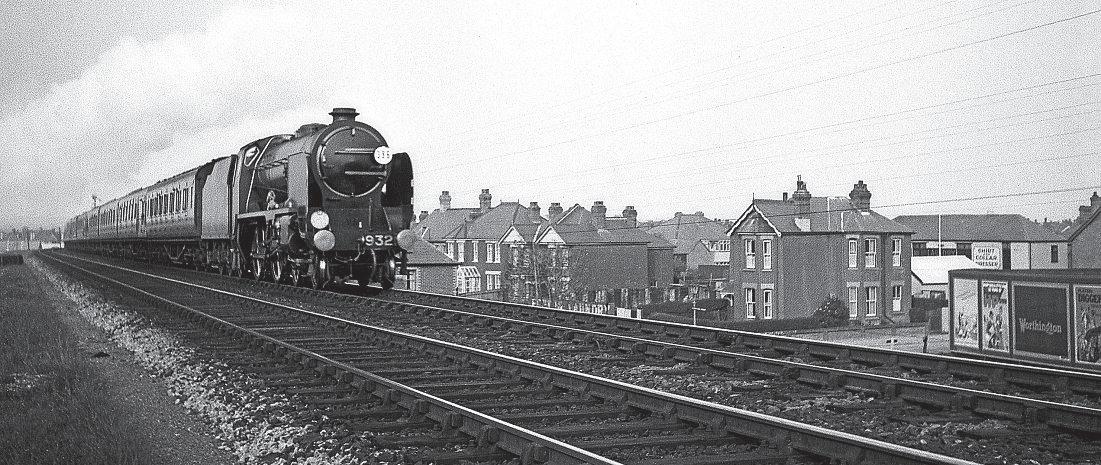

rv icep as tt he pr iv at ep latfor mo nt he la st dayof se rv ices ,S ep te mb er 28 ,1935. Th elin es ou th of he re ro se fr om Hu rn in th is dire ct io no ng ra dients of be twee n1-i n- 66 an d 1- in -8 0a sitt wi st ed an dt ur ne di nt oad ee pc ut ti ng in wh at wa ss om eoft he mo st su bs ta nt ia l engi ne er ingwor ks on th elin e. To th en or th ,t he li ne th en ra nt hr ough seve re cu rves as sh ar pa s 9 - ch ai ns ra dius on th ea pp roac ht ot he Ri ve rAvo nb ri dges Mark Yarwoo d/GW Tr us t
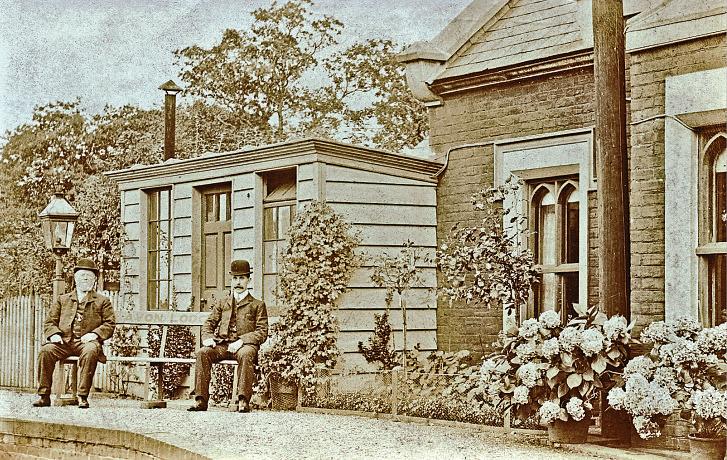
It is unclea rwho theset wo gent lema na re butt he Edwa rdia npenchantfor loca la nd personalised postca rdsprovidesuswit ht hisuniquepicture of theimmaculatelymaint ainedprivate st ation at Avon LodgeH alt. Facilities here included aprivate siding,a nd itsclientele wouldhavebeen residentsoft he cott agea nd estate la bourer sa nd st af f; thenumbermay well have increa sed consider ably af tert he impressive Avon Ca st le wa sconst ructed near by on theriver ’s edge in 1872 . Social changesint he post-Fir st WorldWar er aa nd theriseoft he motorcar no doubteffected theoperation of theest ate, anditwas broken up andsoldoff in lots in 1938 John AlsopCollection
resort forthe frst time.Tis Bournemouth station(opened in Mayofthatyear) was situated to theeastofthe currentCentral station, on theother side of Holdenhurst Road’s tunnel bridge, Holdenhurst Road at the time beingamainroadintothe town from the northeast. Meanwhile, it waseasytosee why therailway hadsuchanefect on Christchurch. It aforded theopportunity forperishable goodstobedispatchedtofar-fungmarkets
andthe opening of thecoastal rail linkfrom Brockenhurst throughSwayand NewMilton in 1888 (today’s SouthWestern Railwaymain line), bypassingthe longer routevia Ring wood andspeedingupthisprocessevenmore. Te railwayalsoenabled theconveyanceof heavygoods in bulk,but most of allitallowed rapidfreedom of movement from distant places, somethingthathad notbeenpossible before.One of thekey resultsofthiswas the
emergenceofthe fedgling touristtrade and theconsequentneedfor hotels.Christchurch wouldbeneftintimewithits ownholiday camp,sadly nowdeparted. Aglanceat Bradshaw’s Handbookof1863, published theyearaferthe railwayfrstarrivedinthe town centre, revealed that theKing’sArmsin Castle Street wasthe recommendedplace to stay (itisstill tradingthere). Market daywas on aMonday(it stillis) andfairs were held on Trinity Tursdayand October17ona site closetothe station, somethingcommemorated in thestreetname‘Fairfeld’. Bradshaw gave thelow-down on theplace:
‘Christchurch(at theconfuence of the Avon andStour) is atowncontainingsome beautifulrelicsofthe past in theruinsofits ancientcollegiate church andprior y, whichare well worthy of notice.Techurch, whichhas been restored,is310 feet long.Ithas atrade in knit andsilkstockings etc.’
He might also have mentionedbrewing as thetownoncehad half-a-dozen breweries, and fuseechain manufacturing,the intricatechains used in theinnards of clocks andwatches, as Christchurch wasoncethe acknowledged capital of this business.Come1866 it became much easier to getfromChristchurchto Salisbur y. Te lineuptoRingwoodwas in place,ofcourse, andthenfouryears afer its openingcamethe Salisbur y& Dorset Junction Railway, whichopeneduparoute,albeita convoluted onebetween theprior ytownand thecathedral city,via Ring wood andWest Moors; therewas no need forthatcoach any longer.Itisanequally convoluted journey today, viaSouthampton.
AboutadecadeaferthatBradshaw entr y, therewas adispute (1872) between theL&SWR andthe residenttof at Avon Castle,who triedtoavail himselfofHarris’ righttofag down atrain at thenearbyprivate halt,onlytohavethe driver ignore him. Te disputecentred around what constitutedan ‘ordinar y’ service, to whichthe rightapplied, anda ‘through’ser vice,towhichitdid not. Te railwaycompany,whichhad introduceda throughser vice from Waterloo,won thecase–it seemed that John Edmond UnettPhilipson Turner-Turner, author of Tree YearsHunting andTrappinginAmerica andthe GreatNorth West,had backed thewrong horse–orrather, hisgrandsonhad.TeL&SWR wasoperating thetrains(andwinningdisputes); come 1874 it hadactuallypurchased theline. Te year before (in Januar y1873), apassingloophad been approved forChristchurch, costing £110. In addition to bringing in holidaymakers, thereliability andconvenience of therailway also attractedriver fshermen whowishedtoavail themselves of theworld-famous salmon fshery, theRoyalty,onthe Avon,whichmeandersdown to Christchurch from Salisburybeforeemptying into Christchurch Harbour. Teywould have foundreasonablebus links too, anothercorollary of therailway’s arrival. Te overall efectonthe town waspalpable–hotelsand boardinghouses opened,and thesea trade dwindled as goods came in andout by train; thelastcommercial vessel lefTownQuayin1938.



de rt he br idge ,w hi le th es li pp ed cr os sove rh er eg avea cces st ot he Down li ne fr om th egoo ds ya rd ad ja ce nt to it .A ni nd ic at or of tr af fc antici pate di st he pr ov is io nofas ho rt ca rr iage dock on both th eU ps id eatt he Bo ur ne mo ut he nd an do nt he Down si de ,a ss ee nh er e; ot
Te original town centreChristchurch stationwas situated slightly to theeast of today’sstation,onthe othersideof theBargatesroadbridge, handilyplaced forreceiving thelinecomingdownfrom Ring wood andHurntothe north. A wonderfulimage from May30, 1862, shows thestafpicturedonthe ‘day of ofcial opening’ –startlingly, thereare 19 menand
thestation dog captured.Tis stationwas short-lived, closinginMay 1886, although thebuildings remained open as afreight depot,withsidings used forwagon storage. Te site of theold station, whichwas a terminus,islostunder alight industrial estate. When today’sstation wasopened, on May30, 1886, in readinessfor thecoastal route, it wouldbea junction stationtobegin
with as theRingwoodlinecontinued to come in from thenorth.Tenew station wassituatedtothe west of thenewly-created junction with thelineontoB ournemouth being‘doubled’ andthe levelcrossingonthe Bargates road beingreplacedbyanew road bridge; thankgoodness they did that as the moderncongestionisbad enough as it is.Te newstation wasowned by theL&SWR and then, from 1923, by theS outhernR ailway In thesameyearthatthe newstation opened (1886), therewas averyserious lineside freon theHurnbranchwhich sawmorethan650 acres of Harris’landupinfames. Harris,orratherhis minions,hackeddowntrees on St Catherine’s Hill to create afre-break,ratherlikedesperate measures takenhaulingdownbuildings during London’s GreatFire. It wasn’t just treesatrisk; therailwayswereinherentlydangerous.In1900, about500 railwaymen were losingtheir liveseach year.In1908 adog dubbed ‘Christchurch Nelson’ managedtoraise £17 10s via thesimpleexpedient of standingonagoods trolleyoutsidethe main entrance; he wassufcientlycelebratedtobe thesubject of apostcardin1910. Sixyears later (1916) therewereatotal of 15 dogs collecting for theL&SWR’s orphanage, with more than 3500 children beinghelpedoverthe years.
Christchurch Road (bynow Holmsley) wasstill making headlines. Onesourceclaims that ‘around1911,’acavalcade conveying theGermanKaiser, WilhelmII, wasstopped by thesignalman at Holmsley to let atrain through, whichapparentlycausedsome annoyancetothe royalparty.I surmisethat it wasmorelikelytohaveoccurredin1907 when it is knownthatthe Kaiser stayed at Christchurch’s HighclifeCastle.
